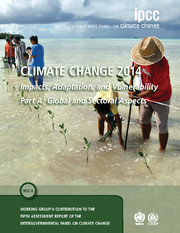 Climate Change 2014 – Impacts, Adaptation and Vulnerability: Part A: Global and Sectoral Aspects
Climate Change 2014 – Impacts, Adaptation and Vulnerability: Part A: Global and Sectoral Aspects Published online by Cambridge University Press: 05 January 2015
12.1. Definition and Scope of Human Security
There are many definitions of human security, which vary according to discipline. This chapter defines human security, in the context of climate change, as a condition that exists when the vital core of human lives is protected, and when people have the freedom and capacity to live with dignity. In this assessment, the vital core of human lives includes the universal and culturally specific, material and non-material elements necessary for people to act on behalf of their interests. Many phenomena influence human security, notably the operation of markets, the state, and civil society. Poverty, discrimination of many kinds, and extreme natural and technological disasters undermine human security.
The concept of human security has been informed and debated by many disciplines and multiple lines of evidence, by studies that use diverse methods (Paris, 2001; Alkire, 2003; Owen, 2004; Gasper, 2005; Hoogensen and Stuvøy, 2006; Mahoney and Pinedo, 2007; Brauch et al., 2009; Inglehart and Norris, 2012). The concept was developed in parallel by UN institutions, and by scholars and advocates in every region of the world (UNDP, 1994; Commission on Human Security, 2003; Najam, 2003; Kaldor, 2007; Black and Swatuk, 2009; Chourou, 2009; Othman, 2009; Poku and Sandkjaer, 2009; Rojas, 2009; Sabur, 2009; Wun Gaeo, 2009).
This chapter assesses the risks climate change poses to individuals and communities, including threats to livelihoods, culture, and political stability. Chapters in Working Group II (WGII) in the Fourth Assessment Report (AR4) identified the risk climate change poses to livelihoods, cultures, and indigenous peoples globally (Chapters 5, 7, 9 10, 16, and 17) and that migration and violent conflicts increase vulnerability to climate change (Chapter 19), as well as highlighting that migration plays a role in adaptation. But this chapter is the first systematic assessment across the dimensions of human security.
To save this book to your Kindle, first ensure [email protected] is added to your Approved Personal Document E-mail List under your Personal Document Settings on the Manage Your Content and Devices page of your Amazon account. Then enter the ‘name’ part of your Kindle email address below. Find out more about saving to your Kindle.
Note you can select to save to either the @free.kindle.com or @kindle.com variations. ‘@free.kindle.com’ emails are free but can only be saved to your device when it is connected to wi-fi. ‘@kindle.com’ emails can be delivered even when you are not connected to wi-fi, but note that service fees apply.
Find out more about the Kindle Personal Document Service.
To save content items to your account, please confirm that you agree to abide by our usage policies. If this is the first time you use this feature, you will be asked to authorise Cambridge Core to connect with your account. Find out more about saving content to Dropbox.
To save content items to your account, please confirm that you agree to abide by our usage policies. If this is the first time you use this feature, you will be asked to authorise Cambridge Core to connect with your account. Find out more about saving content to Google Drive.